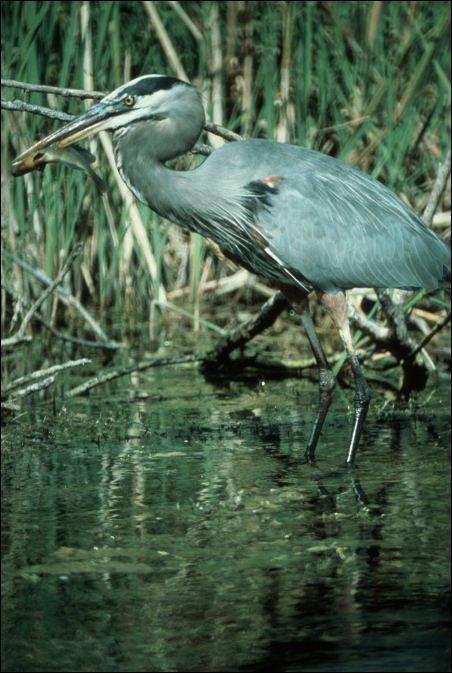
|
Context Kingdom: Animalia |
 |
Great Blue Heron (Ardea herodias). Photograph by John Cossick, courtesy of the U.S. Fish and Wildlife Service. |
Ranges in length from 97 to 137 cm (38-54 in). Weight is 2100-2500 g (74.13-88.25 ounces). With a wingspan of 167-201 cm (66-79 in) (Cornell Lab of Ornlthology, 2003). The adult heron has a white head with black plumes, the neck is brownish-gray, and black shoulder patches, with the rest of plumage a grayish-blue color. Immature herons are duller in color, with a dark cap and lacks plumes (Collins, 1981).
Ardea herodias utilizes shallow waters in marshes, swamps, streams, and irrigation ditches (Collins, (1981). The heron often nests in trees near water, but can be found away from aquatic habitats. Nests often are constructed of sticks and lined with pine needles, moss, reeds, dry grass, or twigs (Cornell Lab of Ornithology, 2003).
Breeding occurs throughout central Canada, west into southeastern Alaska, and south throughout the United States and into Mexico (Collins, 1981).
The Great Blue Heron feeds on a wide variety of prey, including fish, various invertebrates, amphibians, reptiles, birds, and small mammals. It catches its prey by walking or standing and stabbing the prey with quick lunge of the bill (Cornell Lab of Ornithology, 2003). Feeding occurs at all hours of the day, as well as in the evening and dawn, and even during the night when the weather is clear (Audubon, 2005).
The eggs are a dull pale blue, and clutch sizes range from 2 to 6 eggs. At hatching, the offspring are covered in a gray colored down; the eyes are open and they can hold up the head immediately after hatching (Cornell Lab of Ornithology, 2003). During incubation, the male and female sit alternately, receiving food from each other. Nests may also contain a variety of fish and other food (Audubon, 2005).
The Great Blue Heron voice consists of guttural squawks: a frahnk, frahnk, frawnk sound (Collins, 1981). This heron suffered less from plume hunters and pesticides than others, and its numbers have remained strong (Cornell Lab of Ornithology, 2003).
Audubon, J. J. 2005. Birds of America (after 1840 "First Octavo Edition"). Retrieved 27 February 2005, from http://www.audubon.org/bird/BoA/BOA_index.html
Collins, H. H. 1981. Great Blue Heron: Ardea herodias, p. 23 in Harper & Row's complete field guide to North American wildlife (H. H. Collins and J. E. Ransom, eds.), Harper Collins.
Cornell Lab of Ornithology. 2003. All About Birds: Great Blue Heron. Retrieved February 27, 2006, from http://www.birds.cornell.edu/programs/AllAboutBirds/BirdGuide/Great_Blue_Heron_dtl.html#habitat
Unites States Geological Survey (USGS). 2006. Great Blue Heron: Ardea herodias. Retrieved 27 February 2006, from http://www.mbr-pwrc.usgs.gov/id/framlst/i1940id.html
Ruth Rodriguez, March 2006.
